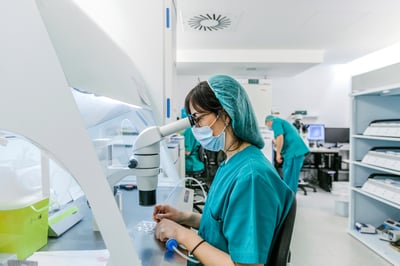This site provides INTERCEPT product information for International audiences Select your region
This site provides INTERCEPT product information for International audiences Select your region
 Despite the diligent implementation of strategies to minimize the risk of transfusion-transmitted infections, blood recipients, who are often vulnerable due to massive bleeding or immunosuppressive treatments are still at risk.
Despite the diligent implementation of strategies to minimize the risk of transfusion-transmitted infections, blood recipients, who are often vulnerable due to massive bleeding or immunosuppressive treatments are still at risk.
Current mitigation strategies have limitations, and the constant emergence of new pathogens result in a persistent threat to blood safety and availability. This could be mitigated by the use of robust pathogen inactivation1.
Pathogen inactivation, a proactive approach, addresses a broad spectrum of pathogens, reduce the need for new testing, and maintain blood continuity and availability for sustained pandemic preparedness2.
Log reduction factors of ≥4.0 log are generally considered the minimum requirement for viruses and parasites based on regulatory standards per the Committee for Human Medicinal Products3. Moreover, clinically relevant levels of infectivity are difficult to define, and the wide variation in immune responses in healthy people and patients may be highly variable depending on disease, therapy, and underlying conditions. Thus, it seems best to assume that there is no safe level of contamination.
Pathogen inactivation systems with high log reduction enable blood product continuity and sustainability during emerging infectious diseases outbreaks, when no licensed screening tests are available4.
Inactivation studies are designed to investigate a system's ability to inactivate the highest infectivity levels to ensure maximum safety margins5,6,7.
“Inactivation of a broad spectrum of viruses and parasites by photochemical treatment of plasma and platelets using amotosalen and ultraviolet A light”8 is a review article recently published in Transfusion. This review is a compendium of previously published or unpublished data that have been obtained to date and together demonstrate the performance of the INTERCEPTTM Blood System ("INTERCEPT") to inactivate viruses and parasites.
Twenty-five enveloped viruses, six non-enveloped viruses and four parasites species were evaluated8:
This review confirms INTERCEPT's ability to reduce transfusion-transmitted infectious risk from a broad range of viruses and parasites which may contaminate plasma and platelet components.
While this review is focused on the inactivation of viruses and parasites, INTERCEPT has proven efficacy to prevent transfusion-associated graft-versus-host disease and bacterial TTIs9, the most significant infectious risk in transfusion today10,11.
References:
1Marks PW, Epstein JS, Borio LL. Maintaining a safe blood supply in an era of emerging pathogens. J Infect Dis 2016;213: 1676-7.
2Domanovic D, Ushiro-Lumb I, Compernolle V, et al. Pathogen reduction of blood components during outbreaks of infectious diseases in the European Union: an expert opinion from the European Centre for Disease Prevention and Control consultation meeting. Blood Transfus 2019;17:433-48.
3European Medicine Agency, Committee for Proprietary Medicinal Products, Document CPMP/BWP/268/95, 1996.
4Rasongles P, Angelini-Tibert MF, Simon P, et al. Transfusion of platelet components prepared with photochemical pathogen inactivation treatment during a Chikungunya virus epidemic in Ile de La Reunion. Transfusion 2009;49:1083-91.
5Goodrich RP, Custer B, Keil S, et al. Defining "adequate" pathogen reduction performance for transfused blood components. Transfusion 2010;50:1827-37.
6McCullough J, Alter HJ, Ness PM. Interpretation of pathogen load in relationship to infectivity and pathogen reduction efficacy. Transfusion 2019;59:1132-46.
7Klasse PJ. Molecular determinants of the ratio of inert to infectious virus particles. Prog Mol Biol Transl Sci 2015;129:285-326.
8Lanteri M, Santa-Maria F, Laughhunn A, et all. Inactivation of a broad spectrum of viruses and parasites by photochemical treatment of plasma and platelets using amotosalen and ultraviolet A light. Transfusion 2020;00;1–13
9Benjamin RJ, Braschler T, Weingand T, et al. Hemovigilance monitoring of platelet septic reactions with effective bacterial protection systems. Transfusion 2017;57:2946-57.
10Castro G, Merkel PA, Giclas HE, et al. Amotosalen/UVA treatment inactivates T cells more effectively than the recommended gamma dose for prevention of transfusion-associated graft-versus-host disease. Transfusion 2018;58:1506-15.
11Kleinman S, Stassinopoulos A. Transfusion-associated graft versus-host disease reexamined: potential for improved prevention using a universally applied intervention. Transfusion 2018;58:2545-63.
Want to stay updated on the latest pathogen inactivation news?
You can receive our highlights by subscribing to our newsletter.
Do you have questions about the INTERCEPT™ Blood System, blood safety or blood transfusions? The INTERCEPT team has plenty of knowledge and expertise.
The information on this site is not country-specific, and may contain information that is outside the approved indications for the country in which you are located.
Use of INTERCEPT Plasma or Platelets is contraindicated in patients with a history or allergic response to amotosalen or psoralens. Consult instructions for use for indications, contraindications, warnings, and precautions.
Cerus, INTERCEPT and the Cerus logo are trademarks of Cerus Corporation.
© 2023 Cerus Corporation. All Rights Reserved. MKT-EN 00157 v43.0